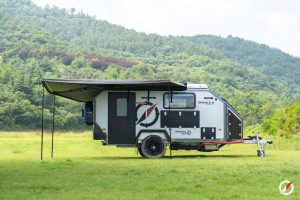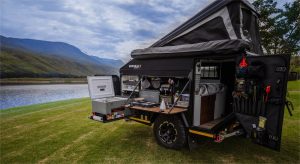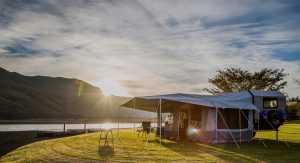This is a great camper. It’s 20 feet long and has really good storage. But one of the things you have to do periodically, and I do it every spring, is go through all these storage containers and become more efficient with what I’m using—making sure what I take on the road is needed.

I use These Velcro straps, and I’m using them more and more to wrap just about anything up, like coax extension cords and power cables. These are great. Don’t forget to bring an extension cord when you get on the road and want to go places. Running a secondary power line from the pedestal will be critical if you want to run something outside in your camp.
You get a nice long length of coax; that way, you can hook up to cable or satellite if the RV park you’re staying at has some. This is something I’d always recommend—this is a 50-amp to 30-amp adapter. Sometimes you might go to an RV park, and they don’t have any spots that are 30 amp, which would be sized for my camper. But they do have larger sites. Sometimes, they’ll have some availability for you, and if you have a 50-to-30, you can still use these sites with no problems.

And this is one of my favorites—for your relatives that don’t realize you’re staying in their driveway for the rest of creation—this is a 30-amp to 110 adapter. So you can run an extension cord underneath your garage door, and they’ll never know.
Lastly, a surge protector is the most critical piece of this ensemble. You need to have this hooked up at the pedestal before you run power to your RV park, regardless of the size or style. What you don’t want to do is have a surge come through the RV park and damage the sensitive electronics in your camper. And to let you know, by a series of lights illuminated on the face, if it’s wired properly.

Now, in keeping with the notion that I’m trying to be as efficient as I can within space—just like everybody else who got into camping a couple of years ago in my previous camper, I went like everybody down to Walmart and bought the water hose. It was terrible. It was hard to keep coiled up. It was hard to store. So, I bought these Zero-G hoses. These guys work like champs. They’re almost three years old. I’ve had them across this country, and when I’m not using them, they go in these containers; they go into storage—no problems whatsoever.
Now, on this potable water line, I’ve got a 40 PSI pressure-reducing valve on the end of that. I’ve got a quick couple that I use, and I also use this in-line filter right at the pedestal to filter the water before it gets to the camper. Our camper has a great filter on the inside, but twice as much filtration is a good idea, so I do that.

Now, I love camping, and one thing that helps me enjoy camping is being prepared to repair something if I have to—worst case—or generally operate the camp when we move from location to location as efficiently as possible.
On this table is a whole bunch of things that I use. These are what I would consider non-discretionary—these are absolute must-haves:
- Screwdrivers
- Wire cutters
- Torpedo levels
- Razor knives
- Channel locks
It’s typical stuff you can find at any local hardware store, but you should take it.
Also, when you’re walking the dog at night or hitching up the trailer in the dark, I highly recommend you have one of these headlamps. They’re very inexpensive. You don’t have to spend much money, but I recommend always keeping one of these inside the camper at night.

I have sockets. I have sockets in the back of the truck to do several things. I have to have a socket that fits the lugs on my tires. I must double-check their torque and ensure the tires are nice and tight. I also have to be able to re-tighten and periodically check my weight distribution hitch to make sure everything’s fully operational and as it should be.
I keep a couple of extra sockets in case I have to manually bring in the awning or bring up or down the power tongue jack in case either one of these electronic devices fails on me in the middle of a trip.
Folks, this goes without saying—always have duct tape—one of the most important things you can take with you. I always keep spare fuses. You never know. I probably don’t need this many, but I always keep a small container of fuses. I keep some wire dikes in case I have to make an electrical change or solve a problem, and I always have an electrical meter so I can check the amperage on my battery to make sure it’s still operating and make sure what it says on the battery is exactly what it says on my power readout inside.
Here’s another DeWalt tool that I bring. Now, this is not the biggest drill I have. This is just a drill. It’s 12 volts. It’s just sized right for slowly and gently taking the stabilizers up on your camper.
I chose this particular battery and size because the drill is just big enough, and these batteries also fit the charger I have for my other DeWalt battery and the other things I use, so I don’t have to bring two different chargers.
This little fitting right here goes on the stabilizers, and the stabilizers go up and down as long as I’m gentle. It’s a lot easier to use a drill to stabilize your camper using a drill than it is having to use that manual hand crank.
I highly recommend you bring ratcheting straps and bungees with you. If something should break or something should happen, you can use ratcheting straps and bungees to solve a temporary problem and get you back on the road where you don’t have to waste any more time than you already have.
Now, here is a Walmart pool noodle. It costs about a dollar. You cut it in half, cut a slit down the middle, stick it on this awning, and when this arm comes up, you won’t be like me—come out of your camper, walk into this arm, and then knock yourself silly. A pool noodle looks goofy but better than a sore head.
Here’s something else you never know. This is a foldable, extendable shovel. Sometimes, you might be on the side of the road and have to change a tire, and because of the land, you might have to do a little digging.
Sometimes, you have to put water in your camper’s storage tank. Use a funnel like this to stick in the hole and help make it easier on yourself. I use this occasionally if I have to wash something, and it stores very easily because of its size—it’s a collapsible bucket.
Now, when you go on the road, there are certain things you have to take with you no matter what. You’ll want to take some things with you just because they improve your experience. These three DeWalt tools fit into that category.
I use this blower to blow all the leaves off my camp, but more importantly, I use it to blow off my awning and my slide, so you don’t have to roll leaves up in your awning and be stuck with the outline of brown tannins for the rest of your lifetime owning this camper.
This little fan will run all night on a heavy-duty DeWalt battery. It keeps everybody nice and cool when you don’t want air but want airflow.
This light has a directional beam. If I have to crawl underneath the camper in the middle of the night or do anything in the dark, I’m just very grateful I’ve got this light with me. One battery fits them all.
We are always messing with this camper, and I did something I’m pretty happy with this morning. I always had a situation trying to store my campsite rug that we put at the base of the steps. So I went to Lowe’s Home Improvement, bought two four-inch pipe straps, used these tech screws (which are metal-to-metal fasteners), and screwed them into the steel piping in the overhead of our storage unit.
We can take our rug now and keep it nice and out of the way. Now, on this side of the camper, we are all business. I keep my sanitary line support in this black container—I don’t know what you call these things, but they help elevate the sanitary line.
Of course, I’ve got my water lines—you’ve seen those already. I’ve got my power, a couple of extension cords, a few adapters, jacks, jack plates, stands, more nitrile gloves, and some parts for my weight distribution hitch. All of these things go on this side.
Then, my chairs. They’re not great but don’t weigh much and store pretty easily. My Andersen levelers, of course, and then a few odds and ends. But that’s basically what we use and how we store it.
One important factor is that you want to keep the weight evenly distributed. A lot of the things that I don’t put in here, such as my fire pit, my Blackstone, and some of the heavier DeWalt tools, I keep in my truck because I don’t want to put any more weight on the hitch with camper than I have to.
While traveling and we were stationary, everything fell over every time I pulled one thing out. So I found these at IKEA—they are bakeware organizers, and there are two of them for around five dollars.
So we went ahead and installed one of these under the cabinet. This is a simple modification. The only thing we did was add some blocking material underneath so that when we screwed this down, it was screwing into something besides the bottom of this cabinet, which is pretty thin.
Okay, so the next modification is what to do with the trash. Now, this large collapsible green trash can is used when cooking or outside. It folds down, I hold it down with binder clips, and it goes behind the sofa.
Or, if we’re outside cooking or out during the day, we keep it outside, and I use the binder clips to keep the plastic trash bags inside. But there’s not much floor space at night, so I don’t like bringing it in at night.
We usually bag the trash, take it to the dumpster at the end of the day, or lock it inside the truck. But I wanted something inside also. So this is what we did.
So, I’m going to walk you through this quickly. It’s very similar to some of the other modifications we’ve done here. We did cut some blocking to go underneath again. And then, because there is this quarter-inch gap, we put a piece of plywood down here so that when we installed the drawer glides, they would come out over the edge without scraping anything.
Whether you’re a weekend warrior or a full-time RVer, being prepared is the key to stress-free camping. From essential electrical adapters like the 50-amp to the 30-amp converter and surge protector to practical storage fixes like IKEA organizers and collapsible gear, every item here ensures efficiency and safety on the road. Don’t overlook the small details—pool noodles for awning safety, foldable shovels for unexpected challenges, or DeWalt tools for quick repairs. By prioritizing smart storage solutions and must-have accessories, you’ll maximize space, balance weight distribution, and focus on what truly matters: enjoying the adventure. Remember, the best trips happen when you’re ready for anything!